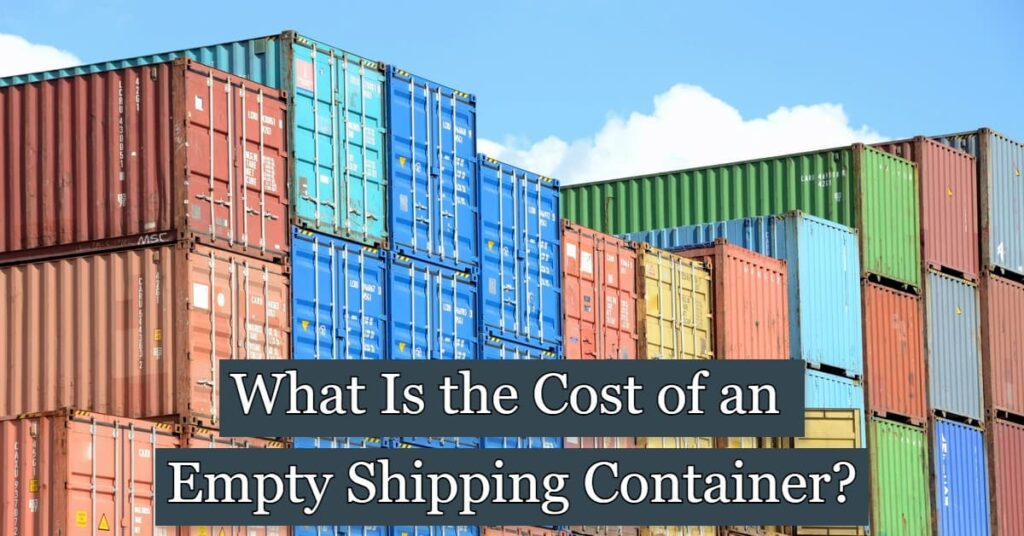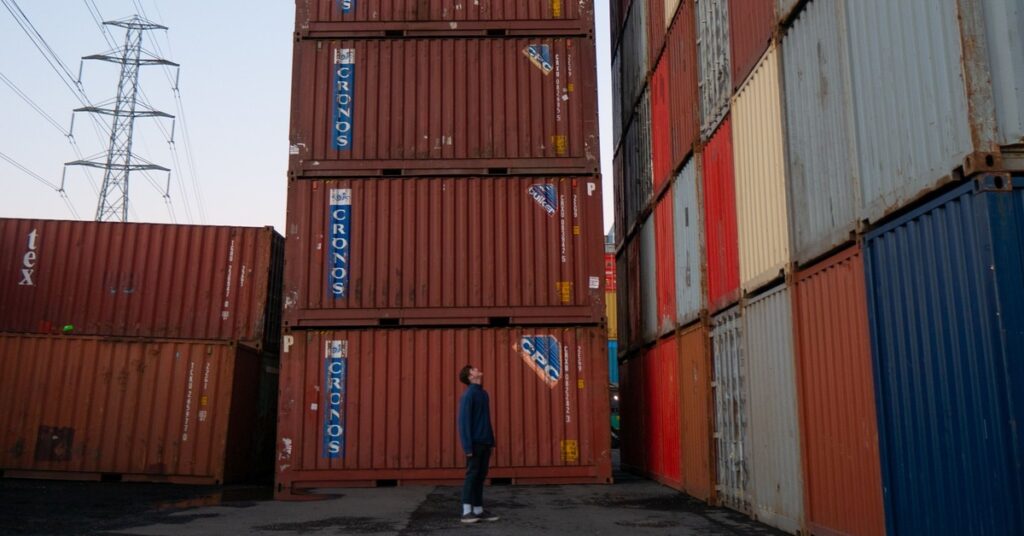Shipping containers might look the same to the untrained eye, but each type has many subtle differences. These variances can significantly affect the container’s overall cost and the company’s buying method.
How much does the average empty container cost? There are various types, and external factors can cause the price to fluctuate. Several purchasing options are available. A shipping company must consider many things before deciding which containers are the most cost-effective.

Average Cost of an Empty Shipping Container
The average cost of an empty shipping container serves as the starting point for most container transactions in maritime trade. According to the International Standardization Organization (ISO), the two standard shipping container dimensions are 20 and 40 feet.
Here are the average costs of a 20- and 40-foot container:
- 20 feet: The smaller standard container costs an average of $2,000 but can range from $1,000 to $3,500. It’s usually the cheapest option available for ships that don’t have much cargo.
- 40 feet: The larger container costs between $2,500 and $4,500. Based on this average range, buying one 40-foot container instead of two 20-foot ones is more cost-effective.
Cargo ships can purchase a mixture of 20- and 40-foot containers, but most utilize one size or the other. It all depends on the carrying capacity and the types of cargo on board. Ultra-large container vessels (ULCVs) and post-Panamax ships almost exclusively use 40-foot containers, while smaller ones opt for 20-foot containers.
The type of cargo comes into play when evaluating the container’s payload. The 20-foot containers have a payload capacity of just over 55,000 pounds, while 40-foot versions can carry more than 61,200 pounds. Companies prefer using 40-foot containers if the vessel is transporting especially heavy items.
The vessel’s design also impacts the buying decision. For example, a company may want to buy 40-foot containers but the deck doesn’t have the layout to safely secure them for the voyage. It would have no choice but to use smaller containers.
Factors That Affect Shipping Container Costs
Many other external factors can influence a shipping company’s choice of containers. Although the size, the ship’s dimensions and the cargo are the most important characteristics, these are just the first few pieces of the puzzle. Here are some other key factors that significantly impact a container’s price and should be considered when developing a budget.
Container Variations
The ISO’s standard 20- and 40-foot containers are the most common, but many others play unique roles. These are the average price ranges for each container variation on the market and what they are best used for.
- Reefer Containers
Reefer containers specialize in storing temperature-sensitive items such as fruits, vegetables, animal products and pharmaceuticals. The inner flooring has T-shaped decking that fills the container with cool air to keep the temperature around freezing. Their electricity and maintenance requirements increase the price to $9,000-$18,000.
Although temp-controlled shipping is more expensive than standard methods, it’s more cost-effective in the long run because it reduces spoilage, waste and liability costs when moving perishable goods. Companies can customize the inner temperature range to meet the cargo’s requirements.
- High Cube Containers
High cube (HC) containers are common variations of traditional 20- and 40-foot options. The length and width remain the same, but the height increases by 1 foot. They provide more storage space and are typically more expensive as a result. Most HC containers cost over $2,000 and can reach as high as $5,000.
HC containers are the go-to options for less-than-container loads that include various products in the same unit. The extra foot of space provides just enough room for employees to reposition products as needed.
- Double-Door Containers
Double-door containers have doors that swing outward at both ends, allowing for easy loading and unloading. This feature is especially useful for transporting cars, construction equipment and other vehicles. Most double-door containers are 40 feet long and cost about $4,500 because the cargo is usually large and heavy.
- Side Door Containers
Side door containers, also known as open side containers, open on the long ends instead of the short ones. This design provides full access to the container’s interior, allowing multiple ship employees to move around at the same time and safely load large items. This container variation mainly deals with bulky cargo and costs between $4,000 and $7,000.
- Open-Top Containers
Open-top containers open from the roof, which consists of a tarpaulin sheet instead of solid metal. Sometimes, vessels leave the roof open to accommodate larger vehicles that can only be loaded vertically. This type of cargo is the largest of all and almost always costs more than $5,000.
- Hard-Top Containers
Hard-top containers have the same function as open-top containers, but the roof is made of detachable steel instead of a tarpaulin sheet. This is the go-to option for cargo that must be loaded from above with a crane or forklift. The solid roof increases the price, with the average range being $5,000 to $8,000.
- Pallet-Wide Containers
Pallet-wide containers are 5 feet wider than standard, which allows them to carry 15 pallets each and transport large quantities of items — also known as neo-bulk cargo. The exterior is all steel, but the floor is wood so the pallets don’t slide around. The price varies between $3,000 and $5,500, largely depending on local lumber costs.
- Flat-Rack Containers
Flat-rack containers only have short sides, leaving the cargo completely exposed. This design makes loading long and narrow items such as piping much easier, but ships use flat-rack containers for various purposes. The typical starting price is $3,000, but that number is increasing because of limited availability.
- Tank Containers
Tank containers, or “tankers,” are cylindrical containers that transport hazardous liquids and gases. That means they must undergo a thorough inspection before being allowed to carry cargo. There are a handful of prohibited substances that tankers aren’t allowed to handle, including certain acids, oils and fats.
- Insulated Containers
Insulated containers look normal on the outside, but the inside consists of double vacuum-sealed walls to stabilize the inner climate. However, unlike reefer containers, they can’t provide precise temperature control. They can only maintain the initial temperature. That means they’re much cheaper than reefer containers, costing $2,500 to $6,500.
- Half-Height Containers
Half-height containers are 20-foot containers with several design options, including an open top, removable sides and swinging doors. They’re often used for transporting dense materials such as stones and coal. The cost can vary widely based on the design specifications, ranging from $2,500 to more than $5,000.

Container Condition
After deciding which type of container to buy, shipping companies must evaluate its condition. The first step is determining whether to purchase new or used. Like any other product, preowned options are almost always cheaper than brand-new ones and are often just as good.
ISO makes it easy for shipping companies to inspect the container’s condition. Each unit has a grade with a specific label. “ISO-approved” containers are in good shape and ready for another journey. They might also have “lightly worn” labels that indicate some damage, but they’re still safe to use.
Material Costs
The cost of raw materials used to produce shipping containers can also impact the price. Pallet-wide containers are a perfect example. Since the inner flooring is made of wood, rising lumber prices have made this type more expensive. Similarly, increased steel prices in the U.S. have caused costs to rise across the board.
The loss of containers at sea also contributes to the scarcity of materials in small part. Each unit that falls overboard makes the surviving containers more expensive commodities, leading shipping companies to sacrifice quality for a lower price.
Location
The purchase location is another key piece of the puzzle. If a company wants to buy containers from one of the busiest container ports, such as the Port of Los Angeles or New York, they might be able to find many cheap used containers. However, prices are slightly higher in the U.S. than in Asia and Europe — especially China and India.
The location of the purchase also affects the delivery rate. Vendors will charge more if the drop-off is challenging to access or requires certain preparations. That’s why most companies prefer to buy from local sellers that charge a flat rate instead of having containers delivered cross-country or overseas.
Buying in Bulk
Shipping containers are no exceptions to the buying-in-bulk rule. Companies that want the best deals for their containers must buy several at once. Sometimes, the number reaches triple digits for a single purchase, like UCLVs. They get a discounted price per unit and don’t have to purchase any more containers for the foreseeable future.
Empty Shipping Containers Widely Vary
The main takeaway from this cost analysis is that empty shipping container prices widely vary. Although there are average prices for the standard 20- and 40-foot options, many factors can increase or decrease outlay by thousands of dollars. The type of container, new vs. used, material costs, the purchase location and buying in bulk are all factors companies must consider before finalizing the purchase.
Frequently Asked Questions
What is the average cost of an empty shipping container?
The average cost of an empty 20-foot container is $1,000-$3,500, while the average price of an empty 40-foot container is $2,500-$4,500.
What is the most expensive type of container?
The reefer container, which specializes in storing temperature-sensitive products, is the most expensive. It can cost up to $18,000 because of the electricity and climate control requirements, so companies should budget accordingly.
What is the least expensive type of container?
A regular 20-foot container without any modifications is the least expensive. All the other types are costlier because they have more specific functions and aren’t as widely available.
What other factors influence the container’s price?
The other key factors that influence the container’s price are its overall condition, the current costs of raw materials, the location of the buyer or seller, and the number of units included in the purchase.
How can shipping companies find a lower rate?
Shipping companies can find a lower container rate by prioritizing used options, staying local and buying in bulk. Doing a bit of homework before investing can make a huge difference in the price paid.
- The Push to Reduce Cruise Ship Carbon Emissions in 2024 – July 19, 2024
- Marine Satellite Internet: How Ships Keep Connected – July 10, 2024
- What to Wear on a Boat – June 24, 2024




Leave a Reply